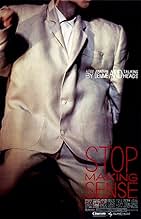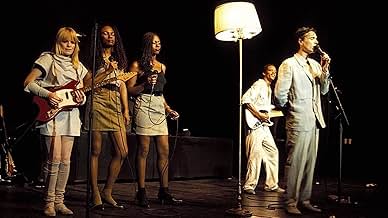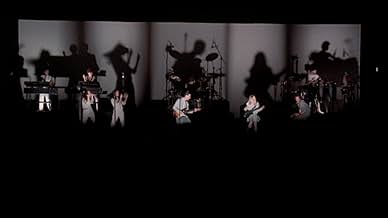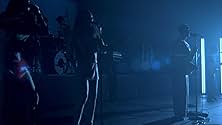VALUTAZIONE IMDb
8,7/10
22.906
LA TUA VALUTAZIONE
Segui il concerto innovativo del gruppo rock Talking Heads.Segui il concerto innovativo del gruppo rock Talking Heads.Segui il concerto innovativo del gruppo rock Talking Heads.
- Premi
- 3 vittorie e 1 candidatura in totale
Steven Scales
- Self - Percussion
- (as Steve Scales)
Ednah Holt
- Self - Backing Vocals
- (as Edna Holt)
Talking Heads
- Themselves
- (non citato nei titoli originali)
Recensioni in evidenza
It's a good thing that the Talking Heads broke up when they did. I mean, could you imagine them slogging it out today, playing the state fair circuit, or worse, the street fair circuit? No, watch this film. See a band at its creative and energetic peak. Remember them as they were over the two or three days in which it was filmed. Of course, you must watch David Byrne. He would make his entire body a performance art. He would contort, jog, dance, leap, and even make his clothes a prop.
But, watch Tina Weymouth...
Tina is a very visual performer too. She says almost nothing, letting her bass guitar speak for her. And while David goes over the top often, Tina is subtle and sublime. With her body moves as she dances in place. With her facial expressions, her smiles, occasional raised eyebrows, and glances. Then when the action shifts to the Tom Tom Club (in order to give David a break and allow him to change into his big suit), her big moment is for one song only--"Genius of Love" but man does she seize the moment and make it all her own! Rounding out the Talking Heads of course are drummer Chris Frantz (Tina Weymouth's husband for over 30 years now) and guitarist/keyboardist Jerry Harrison. When Chris takes the stage, he bounds up onto the riser, bows, and with a big smile, gets drumming. He is clearly enjoying himself during this and at the end of the show, he jubilantly throws his sticks into the audience. Jerry is a little harder to get a bead on. At times he's clearly enjoying himself, particularly on BURNING DOWN THE HOUSE. Other times he seems a little detached.
Rounding out the touring band are Alex Weir on lead guitar, Bernie Worrel on keyboards, Edna Holt and Lynn Marbry on back-up vocals, and Steve Scales on percussion. None are treated as sidemen, rather as an integral part of the show.
It has been commented that some "sweetening" of the sound was done. But I believe that it was to achieve sound consistency. I have heard several concert films with terrible audio (RUST NEVER SLEEPS comes to mind). Seeing this movie is what made me a Talking Heads fan back in 1985. Finding a copy at the used book store in 2006 is what helped me re-discover them.
It would be easy to dismiss the Talking Heads as all visual as all David Byrne. Such is not the case. The songwriting and musicianship was solid throughout the band's career. The band remained together for several more years, scoring several additional hits including AND SHE WAS, LADY DON'T MIND, & WILD WILD LIFE. They called it quits as a band in 1991, although all four members have remained active in music.
But, watch Tina Weymouth...
Tina is a very visual performer too. She says almost nothing, letting her bass guitar speak for her. And while David goes over the top often, Tina is subtle and sublime. With her body moves as she dances in place. With her facial expressions, her smiles, occasional raised eyebrows, and glances. Then when the action shifts to the Tom Tom Club (in order to give David a break and allow him to change into his big suit), her big moment is for one song only--"Genius of Love" but man does she seize the moment and make it all her own! Rounding out the Talking Heads of course are drummer Chris Frantz (Tina Weymouth's husband for over 30 years now) and guitarist/keyboardist Jerry Harrison. When Chris takes the stage, he bounds up onto the riser, bows, and with a big smile, gets drumming. He is clearly enjoying himself during this and at the end of the show, he jubilantly throws his sticks into the audience. Jerry is a little harder to get a bead on. At times he's clearly enjoying himself, particularly on BURNING DOWN THE HOUSE. Other times he seems a little detached.
Rounding out the touring band are Alex Weir on lead guitar, Bernie Worrel on keyboards, Edna Holt and Lynn Marbry on back-up vocals, and Steve Scales on percussion. None are treated as sidemen, rather as an integral part of the show.
It has been commented that some "sweetening" of the sound was done. But I believe that it was to achieve sound consistency. I have heard several concert films with terrible audio (RUST NEVER SLEEPS comes to mind). Seeing this movie is what made me a Talking Heads fan back in 1985. Finding a copy at the used book store in 2006 is what helped me re-discover them.
It would be easy to dismiss the Talking Heads as all visual as all David Byrne. Such is not the case. The songwriting and musicianship was solid throughout the band's career. The band remained together for several more years, scoring several additional hits including AND SHE WAS, LADY DON'T MIND, & WILD WILD LIFE. They called it quits as a band in 1991, although all four members have remained active in music.
I bought this film without ever having seen it. I liked the Talking Heads and had heard about the movie. Suffice it to say that I was amazed! The genious of starting with just a bare stage with David Byrne singing his sublime live version of Psycho Killer, then adding equiptment and band members was so weird, so brilliant. The energy and stamina shown by Mr. Byrne in this film borders on creepy. Was there a mountain of coke backstage, or is he a marathon runner? Not for me to know. How he was able to bend that far backwards during Once In A Lifetime I'll never know! All in all a real concert experience, combining the brilliance and showmanship of the Talking Heads with a master director like Jonathan Demme. It's no wonder that their compilation, Sand In The Vaseline, includes two live tracks seen on the film.
After getting my DVD player, this is one of the first discs I bought. I first saw this movie in the eighties as a fan of the music and was completely floored by a band at their peak. Since then, I've grown to appreciate good cinema as much as music, and I now look at Stop Making Sense from a slightly different perspective.
The movie stands up by any measure of cinematic quality - the direction, the photography, the lighting, the set design, the editing, the performances of the 'actors'. Everything is unquestionably good. A couple of illustrations -
During 'Once in a Lifetime', the camera holds on David Byrne, framing him from the waist up, and doesn't leave him until the very last moments of the song. His performance is absolutely enthralling. I've been trying to think of a movie where an actor holds one shot for so long, and I can't.
The photography and lighting during 'What a Day That Was' are beautiful. The stark white up-lighting reduces a large auditorium and stage to a claustrophobic collage of shadows. The effect is not unlike some scenes in Charles Laughton's 'Night of the Hunter'.
In contrast to some other views posted here, I think the Tom Tom Club's appearance adds a colourful punctuation to the flow of the movie.
The DVD is one of the very few I've come across where the commentary is worth listening to. It switches between all four band members plus Jonathan Demme, and the anecdotes are constantly interesting and often very funny. As a package, this is one of the most satisfying DVD's I own. All the extras are worthwhile and well presented, unlike most 'Special Editions' which are crammed full of junk you wouldn't normally give a second look.
It's a pity that, by its nature, Stop Making Sense will only ever appeal to a small audience, because it deserves to be revered by fans of cinema as well as music. The rock movie genre has only a handful of classics to its name, but Stop Making Sense is its Citizen Kane, its Exorcist, its Godfather, its Star Wars. It really is that good.
The movie stands up by any measure of cinematic quality - the direction, the photography, the lighting, the set design, the editing, the performances of the 'actors'. Everything is unquestionably good. A couple of illustrations -
During 'Once in a Lifetime', the camera holds on David Byrne, framing him from the waist up, and doesn't leave him until the very last moments of the song. His performance is absolutely enthralling. I've been trying to think of a movie where an actor holds one shot for so long, and I can't.
The photography and lighting during 'What a Day That Was' are beautiful. The stark white up-lighting reduces a large auditorium and stage to a claustrophobic collage of shadows. The effect is not unlike some scenes in Charles Laughton's 'Night of the Hunter'.
In contrast to some other views posted here, I think the Tom Tom Club's appearance adds a colourful punctuation to the flow of the movie.
The DVD is one of the very few I've come across where the commentary is worth listening to. It switches between all four band members plus Jonathan Demme, and the anecdotes are constantly interesting and often very funny. As a package, this is one of the most satisfying DVD's I own. All the extras are worthwhile and well presented, unlike most 'Special Editions' which are crammed full of junk you wouldn't normally give a second look.
It's a pity that, by its nature, Stop Making Sense will only ever appeal to a small audience, because it deserves to be revered by fans of cinema as well as music. The rock movie genre has only a handful of classics to its name, but Stop Making Sense is its Citizen Kane, its Exorcist, its Godfather, its Star Wars. It really is that good.
10miloc
At the beginning of the greatest concert movie ever made, we follow a pair of sneakered feet to down center of an empty stage. A voice says "I've got a tape I want to play." We pan up to a thin, nervous-looking man with an acoustic guitar and a boom box. The box starts playing a beat. The man's hand hits a jangling chord. And for the next hour and a half, as the scenery slowly builds around this skinny misfit, we sit transported.
Talking Heads were unquestionably a seminal band in the New York punk/new wave scene. Yet before seeing this film I had little idea of who they were, and even after seeing it I would not necessarily put them on a top ten list. Nonetheless, through a combination of front man David Byrne's charisma and stagecraft, Jonathan Demme's taut, precise filmmaking, and the infectious heat of the music, Stop Making Sense remains the most enthralling and sheerly entertaining rockshow ever. The keening melancholy of "Heaven", the stripped-down mystery of "Once in a Lifetime", the dark funk of "Girlfriend is Better" -- there's simply no duds here. And Byrne works his butt off. He seems to have energy to spare; during one number he simply jogs circles around the stage, as though he needs further exercise. His teammates Tina Weymouth, Chris Frantz, Jerry Harrison, and (eventually) a host of backup singers and musicians click into that energy without a stumble.
This isn't raw work-- clearly this is a conceived film, with defined emotional beats and even a sort of intuitive narrative. And like any band, Talking Heads have a specific sound and style that (I suppose) won't appeal to everyone. But who? I've shown this film to at least three people who never heard of the band before (except through dim memory of early MTV), and even claimed to hate concert movies-- and then they went and bought the soundtrack.
What can I further say? This is a record of performance that cannot be matched. If you like music, at all, clear a little time and watch this movie. I can't promise you won't be disappointed, but I cannot easily imagine how.
Talking Heads were unquestionably a seminal band in the New York punk/new wave scene. Yet before seeing this film I had little idea of who they were, and even after seeing it I would not necessarily put them on a top ten list. Nonetheless, through a combination of front man David Byrne's charisma and stagecraft, Jonathan Demme's taut, precise filmmaking, and the infectious heat of the music, Stop Making Sense remains the most enthralling and sheerly entertaining rockshow ever. The keening melancholy of "Heaven", the stripped-down mystery of "Once in a Lifetime", the dark funk of "Girlfriend is Better" -- there's simply no duds here. And Byrne works his butt off. He seems to have energy to spare; during one number he simply jogs circles around the stage, as though he needs further exercise. His teammates Tina Weymouth, Chris Frantz, Jerry Harrison, and (eventually) a host of backup singers and musicians click into that energy without a stumble.
This isn't raw work-- clearly this is a conceived film, with defined emotional beats and even a sort of intuitive narrative. And like any band, Talking Heads have a specific sound and style that (I suppose) won't appeal to everyone. But who? I've shown this film to at least three people who never heard of the band before (except through dim memory of early MTV), and even claimed to hate concert movies-- and then they went and bought the soundtrack.
What can I further say? This is a record of performance that cannot be matched. If you like music, at all, clear a little time and watch this movie. I can't promise you won't be disappointed, but I cannot easily imagine how.
Before I saw Stop Making Sense I had never been particularly concerned with The Talking Heads, or lead-singer and solo-artist David Byrne. Indeed, I had always been a fan of certain songs, such as "Burning Down the House" and "Psycho Killer", but I had never actually spent time becoming acquainted with the band's music on the whole. However, Stop Making Sense was something I was desperate to view, due to the substantial amount of praise that had been garnered over the years since its release. Now it is safe to say that The Talking Heads rank among my favourite bands, thanks to this masterpiece of musical art.
Essentially, Stop Making Sense is a showcase of the band's collected works. Throughout the 90-minute running-time the concert simultaneously covers the back-catalogue of The Talking Heads, through fluid, non-stop vibrancy. From "Found a Job" and "Take Me to the River" the work is merely a sample of the group's ability to provide some of the most engaging live shows ever recorded. To say that the film is "original" would be an understatement, given that the title still rings true today. Stop Making Sense defines the band's abilities, attitudes, styles and motifs. The New Wave approach the film takes is stylistically engaging to such an extent that it is virtually impossible to draw your eyes away from the screen. Minimalist set-pieces move along with the mood of the music at such a rate that much of the picture feels like a kaleidoscope of blistering sound and trancelike imagery.
David Byrne is the key constituent; bestowing his stage presence, creativity and musical proficiency. His stage dynamics are let loose during Stop Making Sense. The infamously over-sized business suit donned by David Byrne is otherworldly, just like the viewing experience, which transports you into a deep-seated, vivacious trance. Yet it is the suit which distinguishes the work completely. The fact that a regular item of clothing can have the ability to make the wearer seem out-of-proportion and disfigured is both mystifying and captivating. Even more bizarre is that the suit seems to grow relatively larger as the concert progresses. Personal interpretation could be that the suit is an implicative metaphor for the irony of the business world or conformity; on the other hand it could just be about not making sense.
Academy award winning director Jonathan Demme does not just "get the gist of The Talking Heads". Instead he is able to comprehend the themes of the band's work from an unmistakably refined tone that he captures through his direction. The irregularity of the group may be hard for some viewers to swallow, but that can be expected from a group which make music of an acquired taste. As for the choreography, it seems there is none, since the musicians all behave in a volatile and limitless manner. The progressively shifted set-pieces convey the altered reality that you have become apart of, and are an extraordinary example of unbound craftsmanship. Stop Making Sense ultimately displays the band's antics from their perspective; this is due to the extended takes of the performers and the lack of audience shots (the fans can only be seen during wide shots or when the camera moves behind the performers). There are even moments where the viewer effectively becomes apart of the band. A prime example of this manoeuvre is when the camera swings behind drummer Chris Frantz and faces the audience during the rendition of "Thank You for Sending me an Angel."
Characteristically speaking it is hopeless trying to describe the feeling you receive while viewing Stop Making Sense. This is because when seen and heard the mind becomes so fixated with the audacious madness of the piece that every viewer will react differently. Personally, this is the concert which I would irrefutably name as the finest ever recorded, maybe you will too.
Essentially, Stop Making Sense is a showcase of the band's collected works. Throughout the 90-minute running-time the concert simultaneously covers the back-catalogue of The Talking Heads, through fluid, non-stop vibrancy. From "Found a Job" and "Take Me to the River" the work is merely a sample of the group's ability to provide some of the most engaging live shows ever recorded. To say that the film is "original" would be an understatement, given that the title still rings true today. Stop Making Sense defines the band's abilities, attitudes, styles and motifs. The New Wave approach the film takes is stylistically engaging to such an extent that it is virtually impossible to draw your eyes away from the screen. Minimalist set-pieces move along with the mood of the music at such a rate that much of the picture feels like a kaleidoscope of blistering sound and trancelike imagery.
David Byrne is the key constituent; bestowing his stage presence, creativity and musical proficiency. His stage dynamics are let loose during Stop Making Sense. The infamously over-sized business suit donned by David Byrne is otherworldly, just like the viewing experience, which transports you into a deep-seated, vivacious trance. Yet it is the suit which distinguishes the work completely. The fact that a regular item of clothing can have the ability to make the wearer seem out-of-proportion and disfigured is both mystifying and captivating. Even more bizarre is that the suit seems to grow relatively larger as the concert progresses. Personal interpretation could be that the suit is an implicative metaphor for the irony of the business world or conformity; on the other hand it could just be about not making sense.
Academy award winning director Jonathan Demme does not just "get the gist of The Talking Heads". Instead he is able to comprehend the themes of the band's work from an unmistakably refined tone that he captures through his direction. The irregularity of the group may be hard for some viewers to swallow, but that can be expected from a group which make music of an acquired taste. As for the choreography, it seems there is none, since the musicians all behave in a volatile and limitless manner. The progressively shifted set-pieces convey the altered reality that you have become apart of, and are an extraordinary example of unbound craftsmanship. Stop Making Sense ultimately displays the band's antics from their perspective; this is due to the extended takes of the performers and the lack of audience shots (the fans can only be seen during wide shots or when the camera moves behind the performers). There are even moments where the viewer effectively becomes apart of the band. A prime example of this manoeuvre is when the camera swings behind drummer Chris Frantz and faces the audience during the rendition of "Thank You for Sending me an Angel."
Characteristically speaking it is hopeless trying to describe the feeling you receive while viewing Stop Making Sense. This is because when seen and heard the mind becomes so fixated with the audacious madness of the piece that every viewer will react differently. Personally, this is the concert which I would irrefutably name as the finest ever recorded, maybe you will too.
Lo sapevi?
- QuizThe footage was culled from several different shows. In order to minimize the amount of cameras in the frame, one show was shot completely from one side of the stage, and the next night was shot from the other side.
- BlooperThe concert was edited together from three shows and, it being a "live" show, things not planned happened. The first night, David Byrne put on the baseball cap that was thrown on stage from the audience; the next night, it can be seen next to the drums so that he can put it on again.
- Citazioni
David Byrne: Thanks! Does anybody have any questions?
- Versioni alternativeVideo release is 12 minutes longer and features three additional songs not included in original theatrical version.
- ConnessioniEdited into Talking Heads: Girlfriend Is Better (1984)
I più visti
Accedi per valutare e creare un elenco di titoli salvati per ottenere consigli personalizzati
- How long is Stop Making Sense?Powered by Alexa
Dettagli
- Data di uscita
- Paese di origine
- Sito ufficiale
- Lingue
- Celebre anche come
- Talking Heads: Stop Making Sense
- Luoghi delle riprese
- Aziende produttrici
- Vedi altri crediti dell’azienda su IMDbPro
Botteghino
- Budget
- 1.200.000 USD (previsto)
- Lordo Stati Uniti e Canada
- 10.306.902 USD
- Fine settimana di apertura Stati Uniti e Canada
- 41.666 USD
- 21 ott 1984
- Lordo in tutto il mondo
- 13.137.104 USD
- Tempo di esecuzione1 ora 28 minuti
- Colore
- Mix di suoni
- Dolby Stereo(original release)
- Dolby Atmos
- Proporzioni
- 1.37 : 1(original ratio)
Contribuisci a questa pagina
Suggerisci una modifica o aggiungi i contenuti mancanti




























